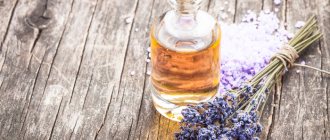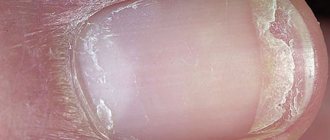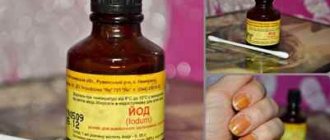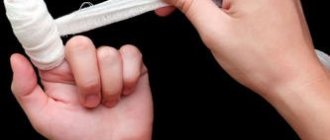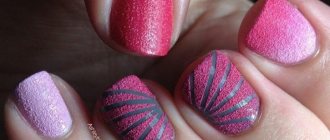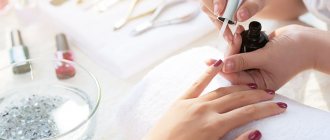Most likely it's a fungus. I need to buy ointment for fungus. It’s best to go to a dermatologist.
99% it's a fungal infection
What makes you think that the smell FROM UNDER your nails will go away if you cut them? what nonsense... It would be okay if the edge stank, but here it’s under the nail.
You know, you seem to have a fungus.
Perhaps you got a fungus if you had a manicure. Now I have to treat.
You need to wipe your ass with paper, not with your nails.
It's a fungus. and very neglected at that. (((you can treat with iodine, but you won’t walk around with nails like that. There is loteryl varnish sold in the pharmacy, it’s good, but it will take a long time and hard to treat. Tested from my own experience.
Have you been trying to cure FUNGUS for many years?
Head of the Institute: “You will be amazed at how easy it is to cure fungus by taking the product for 147 rubles .
Every woman dreams of beautiful and well-groomed hands, and nails play a major influence on their attractive appearance. But deformation of nails due to various reasons does not allow achieving the goal. The question of why the nail plates on the hands change their appearance still remains relevant. Much attention should be paid to the health of the nail plates in children. Their body is at an early stage of development, and any changes may have a more detrimental effect in the future.
The reason is within
The nail plates on the fingers are not only an attribute of beauty, but also a kind of indicator of our body. That's why they require a lot of attention. Many diseases of internal organs and changes in the usual state of the body are the first causes under the influence of which deformation of nails occurs.
Why is onychomycosis dangerous?
When the nail plates are affected by pathogenic fungi, this poses a serious danger to the body. This is not a cold that can be cured quickly and with the help of available drugs.
During their development, fungi synthesize toxins. Accordingly, they provoke the development of dangerous somatic processes, such as:
- Inflammation and soreness of the dermis.
- The presence of blisters and toxicodermic skin lesions.
- Generalized necrosis.
- Spread of the fungus through the bloodstream to other organs and systems of the body.
- Complete destruction of the nail plate in the absence of proper treatment.
- Toxins can trigger the development of cancer.
Signs and symptoms of disease of the nail plate and the skin around it
The initial stages of nail fungus do not always begin to appear directly on the nail plate. Often the pathology manifests itself:
- excessive dryness of the skin of the hands;
- itching;
- presence of cracks;
- redness or inflammation.
Signs of fungal infection may also
- bubble formations between the fingers;
- discomfort and burning sensation in the nail plate area;
- redness of the nail fold;
- the presence of pus in the wounds between the fingers.
Important . The first symptoms are often mistaken for allergic reactions. Meanwhile, the infection spreads further and quickly affects the nails.
The nail plate changes color and turns from pink to cloudy and dull. Yellow or white spots appear along the edges or at the base, which quickly spread over the surface of the nail.
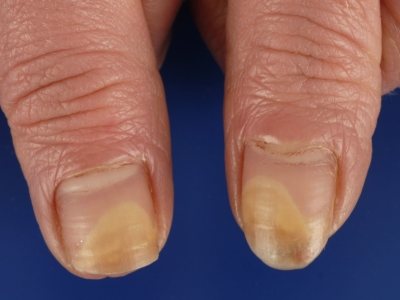
All symptoms of fungus depend on the specific type of pathogen, so before starting treatment, you need to know the form of mycosis.
Signs of mycosis on the nails appear:
- the appearance of spots, grooves and stripes on the nails;
- sharp thickening of the structure;
- color change;
- unnatural convexity or retraction of the nail plate into the bed;
- partial or complete detachment of the nail plate;
- brittleness and looseness of nails.
Sources and provocateurs of infection
It would seem that all people know how important it is to adhere to the rules of hygiene and safety in public places. But until now, swimming pools and saunas are considered the most important source of fungus. Fungus on the feet can cause disease on the hands. Having a disease in your loved ones can cause problems for you too.
Important . The fungus is transmitted through towels, bed linen and indoor shoes.
Also, all the patient’s personal belongings can become a source of fungi:
- shoes;
- manicure accessories and combs;
- blankets and pillows;
- cloth.
Provokes the development of mycosis:
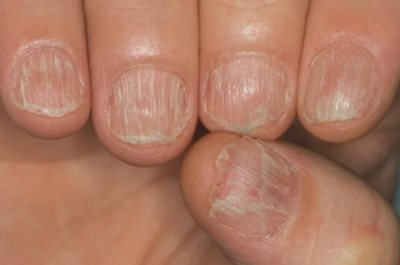
- humid and warm environment;
- blows and bruises;
- vascular pathologies;
- constant stress and emotional tension;
- violation of hygiene rules;
- diabetes;
- long-term use of oral contraceptives or antibiotics;
- the presence of artificial coating on the nails;
- poor nutrition;
- large amounts of sugar in the diet;
- old age.
What the disease looks like: stages and types of fungal nail diseases on the fingers with photos
Primary infection with fingernail fungus occurs almost asymptomatically . It is impossible to understand that spores have got under the nail without visible changes. And with a serious infection, symptoms appear that immediately become noticeable.
Shine
A healthy nail plate normally shines even in the absence of varnish. During polishing, the shine increases even more and is not lost upon contact with water or detergents. Lack of shine is the first sign of the presence of fungus. The surface becomes cloudy and matte.
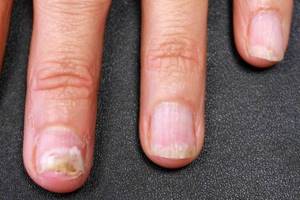
Form
A healthy nail grows evenly, and the free edge moves down slightly.
In the presence of a fungal infection, the growth of the plates is disrupted. The nail looks crooked because one edge grows faster than the other.
Sometimes the free edge may rise up.
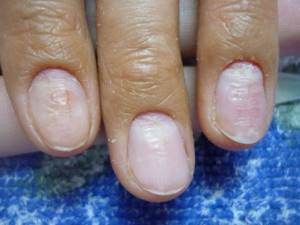
Surface
Healthy nails have an even and smooth surface . When furrows, depressions or bumps appear, you should think about the presence of onychomycosis.
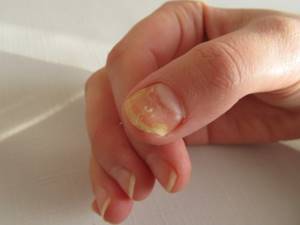
Color
The soft pink and clear color of the nail bed quickly begins to change when athlete's foot is present. The plate becomes yellow over its entire surface. Sometimes streaks, white spots and spots may appear.
Important . The color of the spots can be green, black or brown. This indicates the presence of mold microorganisms.
The initial stage of the fungus is considered to be the moment when color changes have affected no more than 1/3 of the surface of the nail.
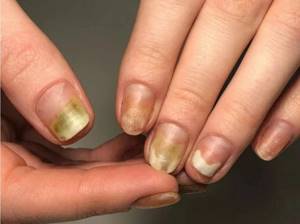
Nail fungus
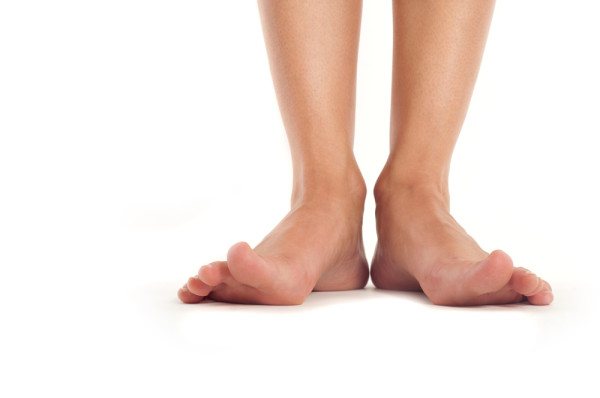
It is interesting that people living in big cities and leading a healthy lifestyle are susceptible to toenail fungus. This is due to the fact that they regularly visit swimming pools, gyms, saunas and other places where the risk of fungal transmission is highest.
There are also factors that increase the risk of fungal disease, namely: increased sweating, poor-quality shoes, synthetic low-quality socks, diaper rash, and neglect of foot hygiene rules. All these risk factors can be easily eliminated from life - you just need to pay attention to it.
There are quite a few types of fungus, they differ in the types of pathogens and, accordingly, manifest themselves in different ways. But the course of the disease almost always follows the same scenario.
Initially, the surface of the infected nails weakens and begins to become covered with small cracks. Sick nails can become rough, partially or completely. Over time, nails change color, stripes and yellow spots appear. A specific unpleasant odor appears from the nails, inside which small voids form. As a result, they begin to loosen and crumble. You should be aware that lack of treatment will lead to complete loss of nails. Also, nail fungus can occur in a latent form, worsening in the absence of appropriate treatment.
If folk remedies for treating fungus are not suitable for you, you should definitely consult a doctor and undergo the necessary examination. It is necessary to visit a doctor even if you suspect a fungus. The sooner treatment of the fungus begins, the greater the chance of getting rid of it and preventing possible relapses.
Toenails are most susceptible to fungus due to the fact that the moisture and heat generated inside the closed nails contribute to its development. Also, using someone else's shoes, such as slippers, may well contribute to infection with fungus. However, do not forget that fingernails are also susceptible to onychomycosis.
Scientists suggest that susceptibility to the fungus is genetically transmitted. In such situations, when one of your parents passed on the gene for increased susceptibility to the fungus, you need to be vigilant and, in case of illness, begin treatment in the early stages.
Damage to the nails can also cause fungus. This is due to the fact that germs can penetrate into the nail cavity, where it does not adhere well to the skin due to injury. Having climbed deeper, microbes begin to multiply. The fungus first attacks the skin and then spreads to the nail.
There are also types of fungi that can be removed with antifungal medications, but they will only work if the fungus has not penetrated very deeply.
What to do at the first signs?
If a person suspects the presence of a fungus, the first thing to do is consult a dermatologist. Diagnostic measures will play a decisive role in therapy. The doctor must determine not only the fact of infection itself, but also determine the type of pathogen. Only on the basis of these data it is necessary to select medications so that they produce a positive effect and suppress the vital activity of specific types of fungi.
The diagnostic examination consists of two stages:
- initial visual inspection;
- taking a microscopic examination and inoculating fungi into cultures.
It is the second method that makes it possible to accurately determine the type of pathogen.
Express diagnosis of nail fungus on the toes and hands
You can determine the presence of fungus at home in the presence of potassium permanganate (potassium permanganate). To do this, you need to dilute potassium permanganate in water so that the water has a faint purple color. Dip nails that you think are infected into this solution for a few minutes. This solution will color the healthy parts of the nail brown, but the affected parts will remain light. If your suspicions are justified, go to see a doctor. After this diagnosis, you should disinfect your nails with hydrogen peroxide.
How to treat an advanced condition?
If the patient ignored the initial stages of the disease and also did not follow the rules, then the disease becomes advanced. The nails become thick, lumpy and gray-yellow in color. Caring for them becomes impossible.
Important . If the matrix is damaged, the nail peels off from the skin and falls off.
The infection also spreads to the hands. Excessive dryness, peeling and cracks occur. The activity of the sweat glands increases and the patient’s hands constantly hurt and smell bad. In case of a complicated clinical picture, it makes sense to use local, folk and medicinal treatment with tablets.
Previously, in such cases, surgical methods were used to remove the nail plate affected by the fungus. But this method is painful and healing of damaged areas takes a very long time. In such cases, an excellent solution is the avulsion method. It involves the chemical “dissolution” of diseased nails with the help of special medications.
The best external remedies - ointments and varnishes
Most often, doctors prescribe the following drugs to treat mycosis:
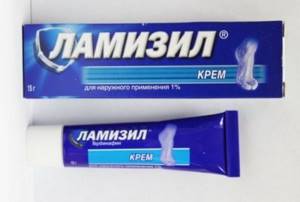
- Lamisil ointment has a wide spectrum of action. The duration of treatment is 3 weeks.
- "Exoderil" in the form of a cream is effective in the treatment of mold and yeast fungi, as well as dermatophytes.
- "Mikonorm" in the form of a cream is a very effective remedy that promotes rapid recovery.
- "Fundosil" is a cream based on zinc and salicylic acid. Suitable for treating all types and forms of fungus.
- Nizoral must be applied several times a day. This is one of the few drugs that has no side effects.
Sometimes, in the fight against the disease, special medicinal varnishes are used, which are used in parallel with ointments and creams.
- "Batrafen" is a varnish based on ciclopirox. Treats 57 types of fungus.
- "Loceril" is an antifungal varnish against many types of fungus.
- "Fukortsin" is an antiseptic and disinfectant solution of bright pink color. Effective against all types of fungus. It is necessary to apply the drug twice a day for two weeks.
- “Demikten” is a varnish based on formic acid. You need to apply it daily until a healthy nail grows out.
All drugs with a local spectrum of action must be used according to the same scheme:
- Wash and clean the surface of the nail plate.
- Trim and file the free edge as far as possible.
- Disinfect tools after treating each nail.
- The prescribed product must be used regularly and in full accordance with the instructions or doctor's prescriptions.
Pills and medicines
Oral medications do not treat fungus alone. Therefore, their use is advisable only in combination with local remedies. The most common and effective are:
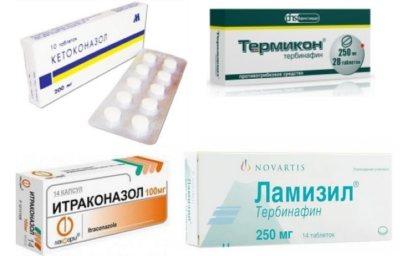
- "Ketoconazole" - the drug inhibits the development of fungi, but causes side effects: nausea, weakness.
- "Futsis" is used at any time of the day. The dosage is prescribed by the doctor and changes it throughout the course of treatment.
- Fluconazole can only be used as prescribed by a doctor. The course of treatment lasts until the healthy nail grows completely, and the dosage is prescribed by the doctor.
- Terbinafine is prescribed only to adults and children over 12 years of age.
Important . If after treatment there is no result, then it is necessary to re-take tests and undergo an examination.
Effective folk recipes
Home remedies will not work without the use of medications, but they will provide relief if necessary.
- Hydrogen peroxide is an excellent antiseptic, but the drug does not kill fungus. Good for disinfection only. Peroxide lotions should be done in addition to the main treatment.
- Propolis is suitable for preparing baths. Add 1 teaspoon of propolis tincture to warm water and hold your hand and fingers in the container for 10 minutes. Then apply propolis to your nails and put on gloves on top. The compress is left overnight.
- Tar soap gives good results in the treatment of mycosis. The affected areas must be soaped, sprinkled with salt and secured with a sterile bandage.
- the garlic in half and apply a clove to each nail. To improve treatment results, it makes sense to take garlic tincture daily before meals.
- Tea tree oil has antiseptic, antifungal and antibacterial effects. It should be applied to the nails twice a day and rubbed in a little.
- Vinegar is mixed with glycerin in equal proportions. The solution must be lubricated on the nail plates several times a day for a month.
- A 5% iodine solution works well against fungus, as it has antiseptic properties. Infected areas should be treated twice daily. During treatment, a burning sensation will occur - this is the effect of the drug. After seven days, complete regeneration of the nail plate will begin.
Each of the folk remedies helps to alleviate the condition, remove discomfort and speed up recovery.
The video presents several folk recipes for treating fungus on the hands:
Hardware treatment methods
A medical manicure using a device is carried out only if the fungus has not managed to penetrate deeply into the nail plate. The specialist removes the top layer of the affected parts of the nails with a milling cutter along with mycosis.
Should I take pills?
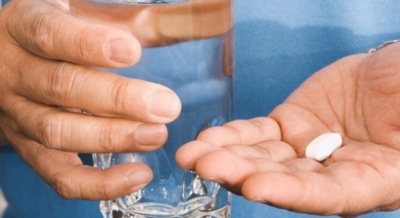
However, treatment must be comprehensive and according to a specific system prescribed by the doctor. Before starting treatment, the doctor must check the condition of the patient’s kidneys and liver using tests and ultrasound diagnostics. In the initial stages of the fungus, you should not take such serious medications.
Drops for toenail fungus
Each of us can face such a nuisance as toenail fungus, because this disease is transmitted by contact. Damage to the nail plates by pathogenic bacteria is called onychomycosis. Treatment of this pathology is aimed at eliminating the infection caused by the activity of pathogenic microorganisms. For this purpose, as a rule, antifungal drugs of general and local action are used. Drops for nail fungus are a topical treatment for onychomycosis.
Indications for the use of such drugs are spots on the nail plates, changes in their color, deformation of the nail, atrophy of the affected part of the nail bed, and its separation from the outer edge of the nail. Do you want to know how to properly apply drops against fungus on nails? What drugs are considered the most effective in solving this problem? Then read our article to the end.
Features of therapy
As already noted, the causative agents of fungal infections can be various bacteria, so the “culprit” of the disease can only be determined after visiting a dermatologist. As a rule, a piece of the diseased nail is taken for examination. After identifying the causative agent of the infection, the doctor prescribes a treatment regimen for onychomycosis. Local drugs should not be taken if the body is individually intolerant to the components of the drug, during pregnancy and lactation, as well as in children under 10 years of age. Otherwise, an allergic reaction may develop in the form of short-term itching and burning sensation, as well as possible redness or peeling of the skin in the area of the affected nails.
Our readers successfully use Tinedol to treat nail fungus. Seeing how popular this product is, we decided to bring it to your attention. Read more here...
Pharmacological properties of drugs
The biochemical mechanism of action of drops from toenail fungus is expressed in the form of destruction of the cell structure of pathogenic fungi, as well as in preventing their reproduction. Such drugs stop the production of ergosterol, the main hydrocarbon compound in the cell membrane of fungi, which causes metabolic disorders in them, as a result, the growth of cells of pathogenic microflora stops.
Drops against fungus on nails are used externally. Their active ingredients penetrate the skin and create concentrations in the layers of the nail plates necessary to eliminate the infection. We invite you to read the detailed instructions for the most effective drops for toenail fungus.
Exoteril drops
This antimycotic drug is active against dermatophytes, yeast and yeast-like fungi, as well as molds of the genus Aspergillus. Apply a thin layer to the damaged part of the nail plate, as well as to the adjacent areas of the skin, and rub in gently. The procedure is carried out once a day.
Terbinafine drops
This drug is used in the treatment of nail fungus, as well as dermatological diseases such as microsporia, trichophytosis, candidiasis and epidermophytosis. Before starting treatment, the affected nail plate is removed using special keratolytic agents, after which drops are applied to the nail bed twice a day.
Ciclopirox drops
The medication in question is active against fungal infection pathogens such as Trichophyton rubrum, Epidermophyton floccosum, Candida albicans, yeast-like and mold fungi. It is also effective against infections by certain strains of gram-negative and gram-positive bacteria.
Ciclopirox drops are recommended for use in the early stages of the disease, when a third or half of the nail plate is affected by the fungus. Before starting the course of treatment, it is necessary to remove as much of the affected nail as possible, and roughen the remaining part using a manicure file. Drops are applied twice a day to the affected areas of the nail and its bed, followed by rubbing. The course of treatment can take from 1 to 6 months.
Prevention
To minimize the risk of contracting mycosis, you must follow some rules:
- Practice good hygiene and wash your hands frequently.
- Use your own towel and manicure accessories.
- Strengthen immunity.
- Do not use false nails or apply acrylic nails.
- Treat your nails with iodine or hydrogen peroxide.
- Dry skin thoroughly.
Compliance with all doctor’s instructions and regular use of medications will allow you to completely cure fingernail fungus within 6–12 months. Pathology is treated faster on the hands, since they are open and do not have such a humid and warm environment as the feet.
How to get rid of unpleasant foot odor
Unpleasant foot odor is a common problem among men and women. Occurs due to various reasons. And only after determining this cause is one or another treatment prescribed.
Causes
Unpleasant foot odor is a common problem. To solve it, it is necessary to find out the causes of the pathology. But it is worth remembering that it is not sweat that thins out unpleasant odors, but microorganisms. Bacteria actively develop in a humid and warm environment, emitting a specific amber around them. The more sweating, the warmer the feet, the more favorable the conditions for microorganisms.
Also, the occurrence of an unpleasant odor can be influenced by various diseases and disturbances in the functioning of internal systems. Therefore, the causes can be divided into pathological and provoking ones.
Pathological causes include:
- hormonal disorders, imbalance;
- constant stressful and nervous situations, phobias;
- fungal infections of the feet or toenails;
- diabetes;
- tuberculosis;
- heart diseases;
- diseases and disorders of the endocrine system.
Provoking reasons include:
- failure to comply with personal hygiene standards;
- wearing socks and shoes made of synthetic materials;
- irregular change of hosiery;
- wearing wet socks and boots.
Troubleshooting
How to remove an unpleasant odor? The first thing they do is identify the cause of its appearance. Any action will be useless if the main factor remains unchanged. If odor appears as a result of a disease, appropriate treatment is required.
But in any situation you must adhere to the following rules:
- observe the rules of personal hygiene. Feet are washed daily using detergents. Particular attention is paid to the area between the fingers, where microorganisms actively multiply. After washing, dry the limbs thoroughly with a towel;
- carry out disinfection. After water procedures, it is recommended to apply an alcohol-based disinfectant. You can also use a mixture of alcohol and vinegar mixed in a 1:1 ratio;
- wear socks/stockings and shoes made from natural materials. Hosiery must be made of cotton. They need to be changed daily. Shoes should be chosen from genuine leather or breathable fabrics;
- wear open shoes in summer. At a minimum, warm-weather shoes should be open-toed. You cannot wear shoes made of rubber or plastic;
- Do not wear wet socks or shoes. When wet, you need to remove socks and shoes as quickly as possible;
- take proper care of your shoes. It must be washed regularly, cleaned from the inside, and dried thoroughly. It is allowed to use deodorizing agents for treating shoes.
There are also various means to combat the problem. These include medications (creams, ointments, etc.), deodorants, traditional medicine, and used at home.
Medications
A number of medications are prescribed to treat excessive sweating and prevent the development of harmful microorganisms.
Such means are:
- Teymurov pasta. The composition with salicylic and boric acid, zinc oxide and talc helps dry and disinfect the skin. Prescribed for excessive sweating. Treat the feet before going to bed for 3-4 days, then take a break;
- formidron. The drug contains formaldehyde, which has an antiseptic and deodorizing effect. Apply to problem areas and between the toes once a day. Long-term use may cause dry skin;
- boric acid. Antiseptic properties help in the fight against the unpleasant odor emanating from the feet. The dry preparation is poured into socks, which are then put on. Treatment is repeated for 5-7 days, after which a break of one week is taken. The course can then be repeated;
- lavender essential oil. The product is a natural antiseptic, effectively treats fungal infections, and refreshes the skin. Make a foot bath with lavender oil, repeat the procedure 2-3 times a week;
- burnt alum. The drug is a powder made from natural potassium-aluminum alum. Used as a powder: treat the feet with the composition in the morning, and wash off the product in the evening. Alum absorbs sweat and has a negative effect on germs and bacteria.
Deodorants
What to do to get rid of bad foot odor? One solution to the problem is the use of deodorants. They come in various forms: spray, cream, lotion or talcum powder.
Creams and lotions help not only eliminate unpleasant odors, but also reduce sweating and care for the skin of the feet. The effect of some drugs is designed for 5-7 days. The protective effect remains even after washing your feet.
Deodorants are divided into several types:
- antiperspirants. The effect is based on blocking the sweat ducts. These include FRESHFOOT, Odor Control Neutra-Activ, etc. Antiperspirants should not be used around the clock, as they clog the pores on the skin;
- deodorants that normalize sweating. The composition contains components that reduce sweating. The products do not close sweat channels. These include Vichy 7 days, DRY-DRY, Deo control, Lavilin, 5 days, etc.;
- medicated deodorants. Destroy microorganisms, preventing odor from appearing. These include Gevol honey.
Medicinal deodorants are not recommended for constant use. Microorganisms get used to the destructive effect of the drug and, over time, retain their vital functions.
Folk remedies
Folk remedies are used to combat foul foot odor. The following substances are most effective:
- starch. The product is sprinkled on clean and dry feet (similar to powder), then socks and shoes are put on. Starch absorbs excess moisture and prevents odor formation;
- lemon. Citrus zest contains essential oils that act as a disinfectant, drying and flavoring agent. Lemon peel is applied to clean, dry feet and toes;
- Oak bark. One of the most effective ways to get rid of the smell of sweat is to take baths with oak bark. The component contains tannins, which dry out the skin and narrow the sweat ducts. To prepare a therapeutic bath, soak 1 tbsp in 1 liter of boiling water. spoon of crushed oak bark, leave for 20 minutes. For a positive result, it is enough to carry out 10 procedures. In the future, repeat periodically for prevention;
- sea salt. The product has a negative effect on bacteria and fungus and dries out the skin. Every night, take baths with sea salt (2 tablespoons per 1 liter of water) for 10 minutes. You can add baking soda to the solution. An alkaline environment kills fungi; laundry soap. Helps get rid of germs and reduces sweating. But soap dries the skin very much, so you shouldn’t wash your feet with it every day. It is enough to carry out the procedure every 3-4 days;
- Black tea. The product tightens pores, reducing sweating. To prepare a bath, 20 g of black tea is poured into 250 ml of boiling water, left for 10-15 minutes, poured into a basin and diluted with warm water;
- vinegar. Destroys germs, fights foot fungus, and has a deodorizing effect. Used in the form of baths: 1 tbsp. pour a spoonful of vinegar into 1 liter of warm water and dip your feet into the solution. The procedure can be carried out 1-2 times a week.
